#Susanna Horenbout
Text
controversially (in this very limited milieu, anyways) i think apologism of the boleyn men has gone a bit too far in the other direction. how-ev-er, i am extremely tired of authors portraying george as a rapist and then being like but he was arrogant, but he was an asshole (he was, and he could be, posting “” relevant to this later) and so on & so forth in their author’s note pages. like. why are you lazy, tho? there are many others way to portray which characters are domineering and have asshole potential. ways that do not involve SA. ways that are not shorthand to both elevate your narrator and demonstrate that the boleyns that are off the page are also, by association, one-note evil paper dolls.
#CR would never do this to me. and in fact. he did not#but i doubt those books will be adapted bcus i have never interacted with anyone else who’s read them 😭#make an effort gun.jpeg#susanna horenbout pov and you go oh niche and then it’s very flat and this is their only mention of gb? oooh…kay#??
6 notes
·
View notes
Note
I read a theory that these and other miniatures thought to be originals were copies ordered by Mary I or Elizabeth; you can see why, as the ones for which we have another example have more detail and are less "washed out"

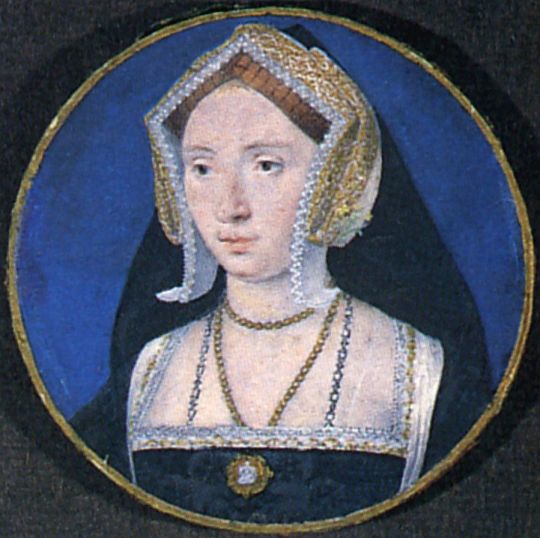

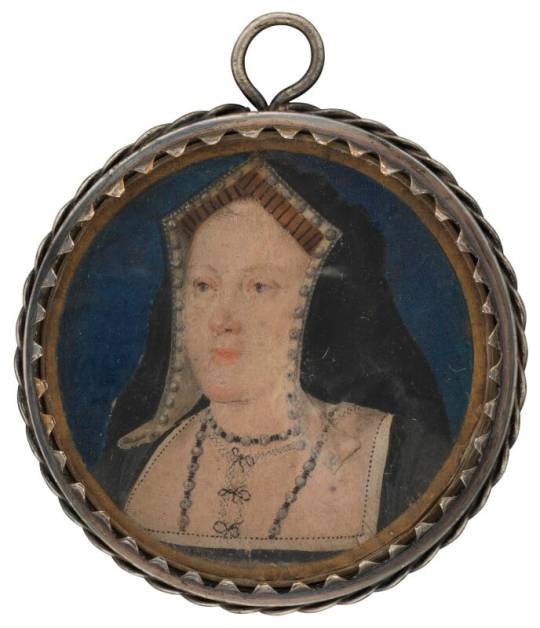
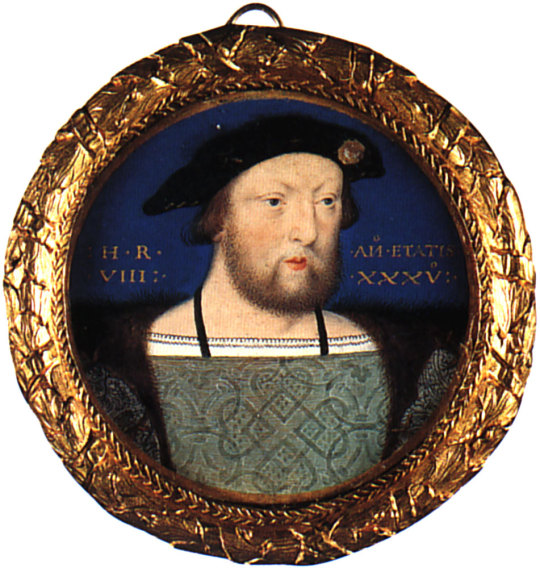

This theory put Levina Teerlinc, court miniaturist to Elizabeth I, as the copyist, and included these in the set as ones for which we no longer have the original (Katherine Parr and Mary Tudor):

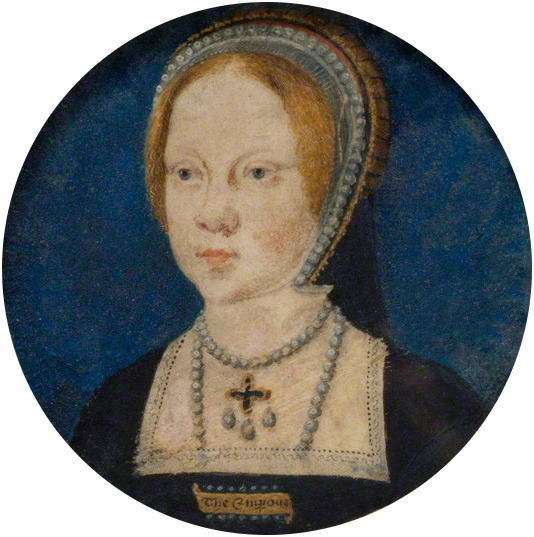
Imo, it is not impossible for excellent copies to be hiding among originals. Especially since miniatures don't have as many options for testing as larger portraits do.
Lots of artist created copies of previous works, some of them are truly master-level forgery/copy which is truly hard to tell apart.
However in Tudor times there was also normal for royalty to have portraits which i call 'twins' where posture is exact same, but outfit-gown, jewelry is different.

Sometimes entirely, sometimes only tiny bit.
That is in my opinion the case with Henry's miniatures above also.
Since twins can be separated over the centuries, they can be in starkingly different conditions, which can sometimes account for washing out of the colours. Sometimes also it is quality of the photograph.
(I also explained in my previous post that two of those miniatures could be same person, but different year-just very close in time. Which is unsually fast for non-royal.)
The differences in style can also be hard to determine because Lucas Horenbout was not the only miniaturist working for Tudors prior to Levina Teerlic. There was several of them, and only one who we can recognize is Holbein.
Thus it is harder to tell which miniatures are truly from reign of Henry VIII.
We cannot even tell if miniatures atributed to Lucas might have not been created also by his sister Susanna. Workshops normally are very difficult. Family workshops? near impossible to tell who did what.
But among all those you shown, there is one which I even believe to be a copy. Not that the style wouldn't match. The face is excellent.
It's wrong format. Chance that this is sole square miniature, in sea of round ones, I don't buy it.
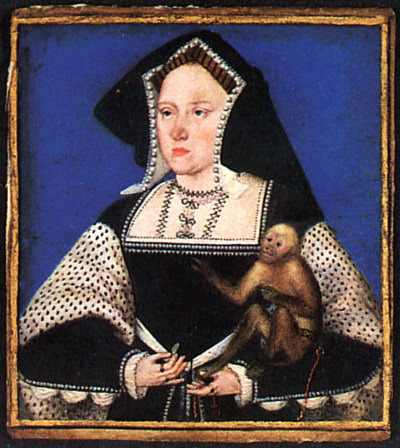
My theory is that it was created during reign of Mary I. (Because why would Elizabeth I have it made?) To be match to Henry's existing miniature, which is set within square, but is round.
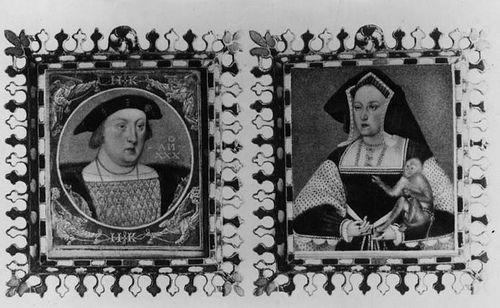
And the person changed the veils of the gable hood to style which appears in c.1526-1527-thus Catherine would have worn it, but with different ends of paste.
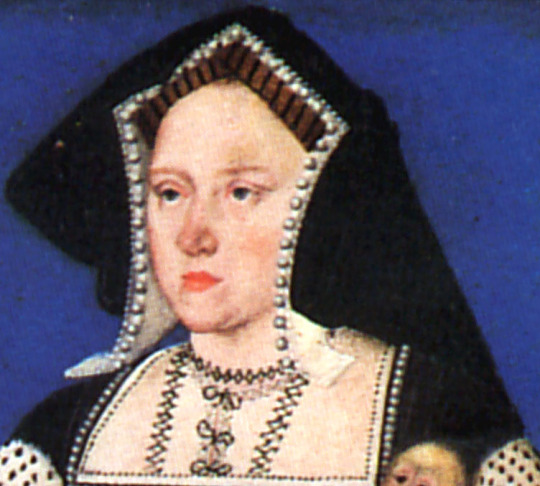
Imo it copy after this one on left-which is not so pleasing to the eye-but that is Horenbout's style. He could make anybody look unflattering.
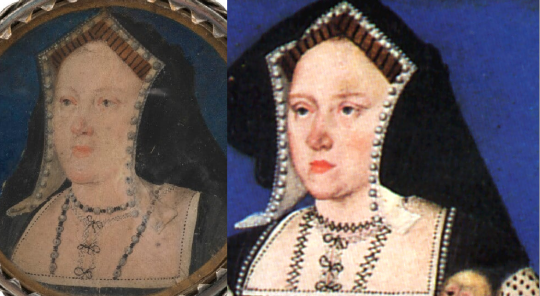
The necklace was turned into weird thing i cant ven describe(and it never appears anywhere else), pearls were added around bodice. Paste ends are not traluscent-as they shouldn't be. But i think on original Horenbout might have fixed that mistake, only for that layer to worn off over time.
Rest of the outfit is probably based upon this painting(i played with its backgroud because you couldnt really see ends of black veil)-which also has proper necklace:
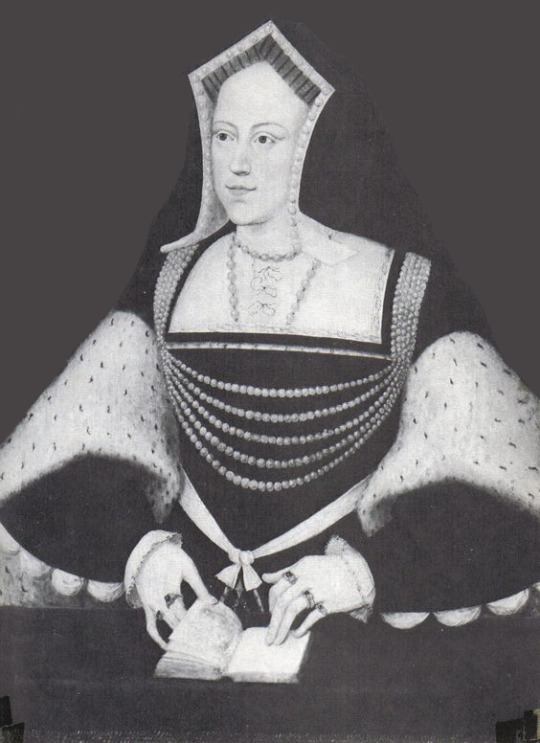
Imo it and the original round miniatures are so alike in outfit and posture, we could even consider them 'twins'...although one by miniaturist, one by another artist.
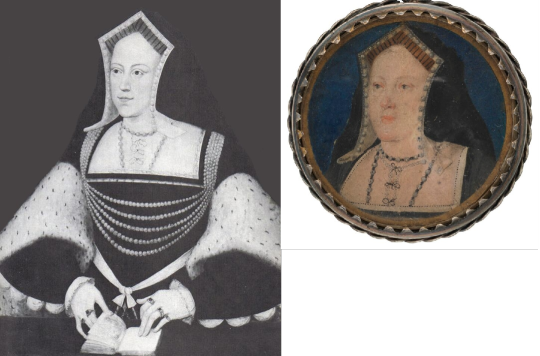
Closer inspection reveals minor differences such as extra pearl trim to veil on right, the difference to chemise embroidery and edge, pearl chains on shoulders.
The one on right(bellow) has nearly identical face, yet none of the issues with the outfit. Thus i don't suspect that one.
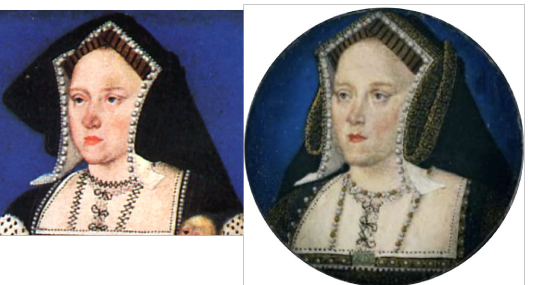
What i am trying to say is that yes, there can be well-made copies, which are being labeled as originals. Or were in past.

But just as copy can be thought to be original by public or experts, the original can be overlooked, because it is believed to be a copy.
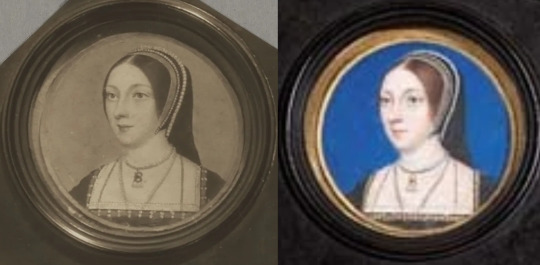
Also, dont think that the copy cannot be contemporary. Some of the ugly copies of Henry VIII are provenly just few years older than his original paintings.
Thus not only you can have copies made during reign of Mary I or Elizabeth I, you can have copies created in 1530s or 1540s. Possibly even by original artist. Holbein did it with portraits of Jane!
And not all of them are of same quality! Despite being originals.
Because they were comissioned by different people. -that can affect colours. But the outfit should fit her lifetime in each.
What one has to do is not take their word for it. Investigate, nitpick over the details or sent me pictures and I will do it for you.
3 notes
·
View notes
Text
Susanna Horenbout Series
Intrigue and romance in King Henry VIII’s court…
Congratulations to author Michelle Diener on the release of this stunning series! Starting June 16th, In a Treacherous Court will be FREE to download from Amazon but it’s only for a few days!
In a Treacherous Court (Susanna Horenbout Book 1)
Henry VIII’s most lethal courtier and his newly appointed artist become the only thing keeping him on the…

View On WordPress
1 note
·
View note
Text
Susanna Horenbout Series
Intrigue and romance in King Henry VIII’s court…
Congratulations to author Michelle Diener on the release of this stunning series! Starting June 16th, In a Treacherous Court will be FREE to download from Amazon but it’s only for a few days!
In a Treacherous Court (Susanna Horenbout Book 1)
Henry VIII’s most lethal courtier and his newly appointed artist become the only thing keeping him on the…

View On WordPress
0 notes
Text
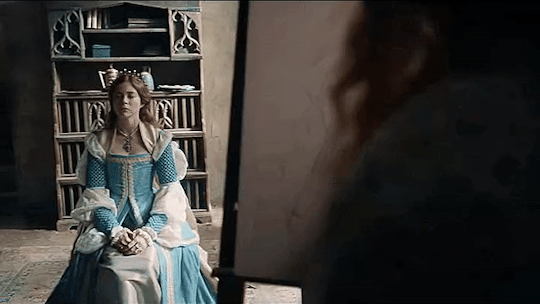
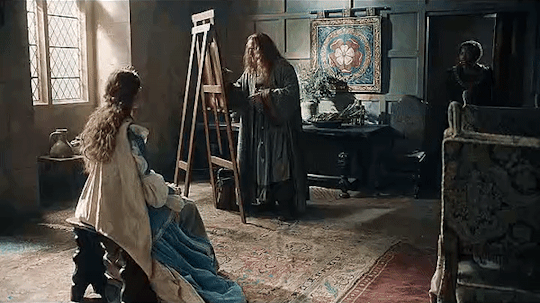
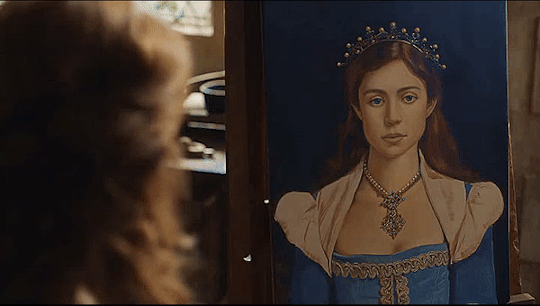
If time and the partisan bitterness of a revolution have dulled the memory of Catherine’s relations to her poor commons, they have also almost obliterated the traces of what was perhaps the most important service of all her peaceful years as Queen: her encouragement of the new learning, and fostering care for the classical Renaissance in England, so short-lived. Her patronage of learning was not ostentatious, and much of it was bestowed indirectly, through her husband.- Garrett Mattingly, Catherine Of Aragon
The Horenbout was a family of Flemish artists who gained international acclaim during the late 15th and first half of the 16th centuries. The patriarch Gheraert rose to become court painter to Margaret of Austria, regent of the Netherlands. It is convenient to remember that Margaret was one of the most recognized artistic promoters of the period and her bond with Catherine of Aragon was always close and of mutual collaboration.
Gheraert trained three of his six children in his Ghent workshop, two of whom, Susanna and Lucas, went on to have successful careers at the English court. The family specialised in manuscript illumination and were pioneers of the miniature portrait. In 1522, at Henry VIII’s invitation, the Horenbouts arrived in England and set up a workshop, where they produced portrait miniatures, royal portraits, designs for glass, tapestries and ecclesiastical vestments, and manuscript illuminations deifying the Tudors.
There are references to Queen Catherine's work as promoter of commissions such as illuminated prayer books and evidence that Catherine commissioned works to Susanna and Lucas Horenbout. Upon her arrival in England, Susanna was assigned to the household of Catherine of Aragon where missing chamber records make it impossible to know her original title or wages. Both Susanna and Lucas were creating miniatures for the king and queen as early as June 1522 when the miniature of Princess Mary at the age of six was painted to celebrate her betrothal to Charles V. All this points to a relationship of artistic promotion of the queen with these artists and, specifically, with the first woman Renaissance painter in the Tudor court. Evidence shows that Henry’s first queen, as with his later ones, presented small portraits of herself to members of her chamber.
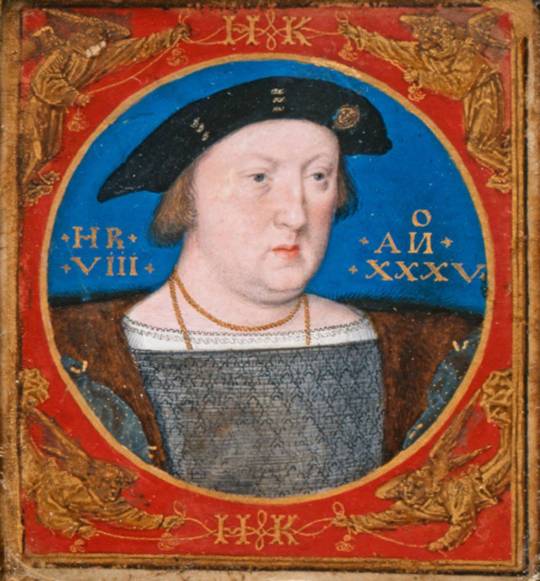


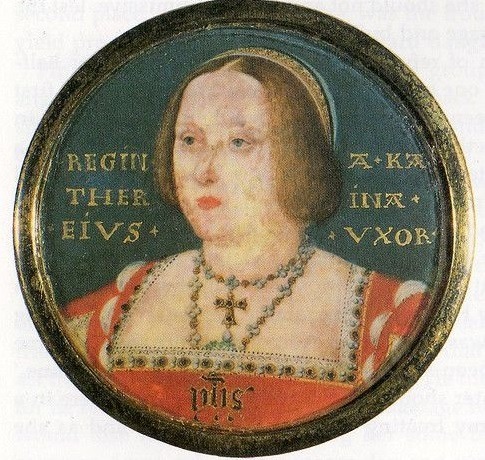
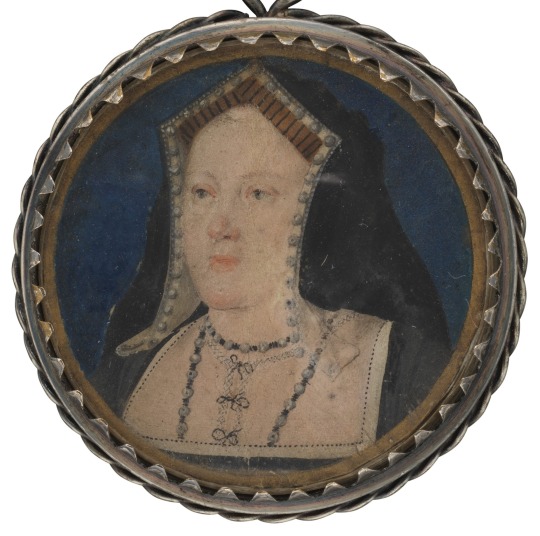
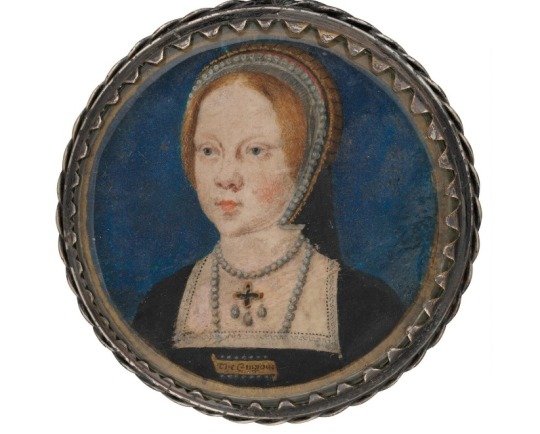
The Horenbouts undertook was a deep understanding of diplomacy and the ability to work for competing factions at court while keeping above the political fray. Susanna Horenbout was producing illuminations for Wolsey and Catherine of Aragon while her brother and her father were chosen to create public statements of authority for Anne Boleyn.
Susanna seems to have embarked on a project for Cardinal Wolsey, the illuminations for the EpistleLectionary and Gospel-Lectionary commissioned between 1528 and 1529. These years at the end of his life were particularly fraught ones for the cardinal, who was caught in the crosshairs of the king’s efforts to force the papacy to agree to an annulment of his marriage with Catherine of Aragon. And on folio 40 r of the EpistleLectionary, tucked into a crowd of the Blessed, flanking the pope wearing a blue cope decorated with Brears’ ringed-pellet design, are the personal portraits on the left of Wolsey, supported by St. Lawrence, patron of the church in Ipswich where he was baptized, and the king, supported by St. George, together with Catherine of Aragon in a red gown standing next to St. Barbara, patron saint of Aragon, on the right.
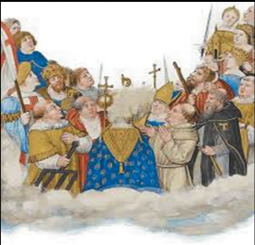
Sources:
Susan E. James, The Horenbout family workshop at the Tudor court, 1522–1541: Collaboration, patronage and production.
Emma Luisa Cahill Marrón, Catalina de Aragón (1485-1536), del análisis biográfico a la promoción cultural y artística: un estado de la cuestión
#Catherine of Aragon#Katherine of Aragon#Catalina de Aragón#Wolsey#Henry VIII#Lucas Horenbout#Susanna Horenbout#Gheraert Horenbout#Margaret of Austria#Mary Tudor
43 notes
·
View notes
Photo
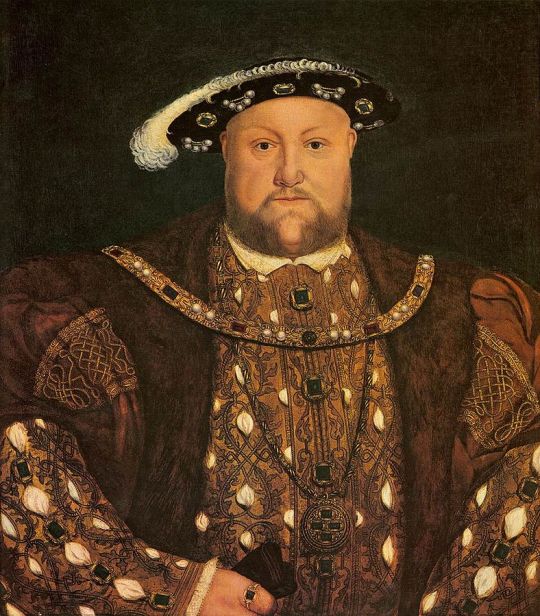
Lucas Horenbout (1490–1544) After Hans Holbein (1497/1498–1543) - Portrait of Henry VIII - ca. 1526
Lucas Horenbout, often called Hornebolte in England (c.1490/1495–1544), was a Flemish artist who moved to England in the mid-1520s and worked there as "King's Painter" and court miniaturist to King Henry VIII from 1525 until his death. He was trained in the final phase of Netherlandish illuminated manuscript painting, in which his father Gerard was an important figure, and was the founding painter of the long and distinct English tradition of portrait miniature painting. He has been suggested as the Master of the Cast Shadow Workshop, who produced royal portraits on panel in the 1520s or 1530s.
Horenbout was born in Ghent, where he trained with his father, Gerard Horenbout, becoming a Master of the local Guild of Saint Luke in 1512. Gerard was an important Flemish manuscript illuminator in the dying days of that art-form, who had been court painter, from 1515 to about 1522, to Margaret of Austria, Regent of the Netherlands. Margaret was twice sister-in-law to Catherine of Aragon, still Henry's (first) Queen when the Horenbouts came to England. Gerard is sometimes identified with the "Master of James IV of Scotland", one of the many artistic personalities identified as a significant illuminator in the Ghent-Bruges school of the period, to whom no historical person can be attached.
Horenbout came over to England at an unknown date with, or perhaps before, his sister Susannah Hornebolt and his father. It has been suggested that their move was in connection with an attempt by the King, or possibly Cardinal Wolsey, to revive English manuscript illumination by establishing a workshop in London, but this is controversial. His father Gerard is first recorded in England in 1528, and later returned to the Continent, probably after 1531; he had died in Ghent by 1540. Susanna, who was also an illuminator, is recorded in 1529 as married to a John Palmer and in England.
Lucas is documented in England from September 1525, when he was first paid by the King as "pictor maker". By 1531 he was described as the "King's Painter", and this appointment was confirmed for life in June 1534, when he became a "denizen" - effectively a naturalised citizen. Horenbout was very well paid, at sixty-two pounds and ten shillings (but only thirty-three pounds and six shillings according to Richard Gay) per year, a "huge" sum according to Strong, and better than Holbein's thirty pounds a year in his period as Henry's court painter. He was granted a "tenement" in Charing Cross, and permitted to take on four foreign journeyman. Lucas died in London, and was buried at Saint Martin in the Fields and left a wife and daughter, Margaret and Jacquemine. Margaret was paid sixty shillings three years later by Queen Catherine Parr for some paintings.
13 notes
·
View notes
Text
ARTE RENACENTISTA
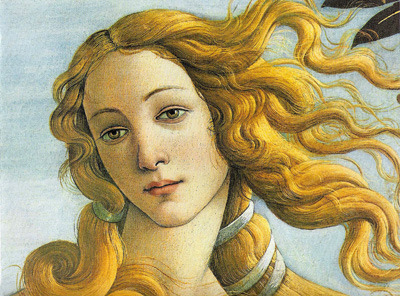
El renacimiento en Europa no fue un sitio prometedor precisamente para las artistas emergentes. De las mujeres se esperaba que se casasen y tuviesen hijos, y aquellas que trabajaban no eran bienvenidas a las profesiones dominadas por hombres. De hecho, las mujeres no podían recibir información en las artes.
Pero algunas consiguieron emerger. Gracias a las enseñanzas privadas, generalmente dadas por los
padres que las estaban guiando dentro del negocio, eran suficientemente talentosas como para ganar comisiones por sus propios medios, algunas mujeres consiguieron hacer sus vidas como artistas.
A continuación pasamos a conocer algunas artistas que despuntaron en su tiempo.
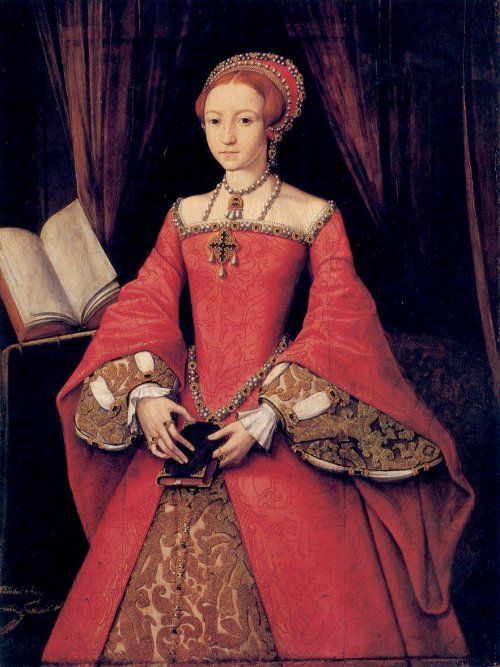
Levina Teerlinc
Pintora flamenca (ca.1510-1576) que trabajó como pintora en la corte inglesa de Enrique VIII, Eduardo VI, María I y Elizabeth I. Fue la miniaturista más importante en la corte inglesa entre Hans Holbein el Joven y Nicholas Hilliard. Su padre, Simon Bening era un famoso iluminador de libros y pintor en miniatura de la escuela de Gante-Brujas y probablemente la formó como pintora de manuscritos. Pudo haber trabajado en el taller de su padre antes de su matrimonio.
Poco se sabe acerca de su carrera o entrenamiento tempranos, pero en 1545 fue invitada a la corte de Enrique VIII, que había sido el patrón de Hans Holbein y Lucas Horenbout (quienes habían fallecido recientemente), y fue nombrada “dolorosa” real. Después de la muerte de Henry, ella continuó en este papel bajo la reina Mary I y la reina Elizabeth I.
Limitó su producción a las miniaturas de retratos, que son recuerdos personales que tienden a dispersarse ampliamente y no se muestran formalmente como lo son las pinturas de tamaño completo. Como resultado, ella es menos conocida que sus predecesoras y es más difícil atribuir sus obras con autoridad. De hecho, a pesar del hecho de que se sabe que ella pintó a muchos miembros de la corte, solo hay un puñado de obras que se le atribuyen y ninguna que definitivamente se sabe que está en sus manos.
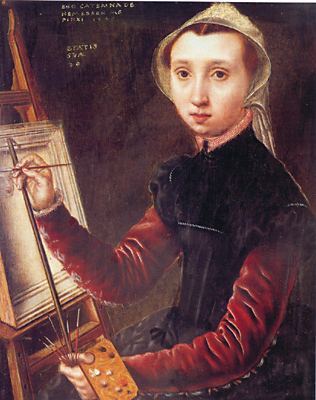
Caterina van Hemessen
Pintora flamenca 1527-1587. Fue miembro del Gremio de San Lucas e incluso se convirtió en maestra de tres estudiantes varones. El patrón principal de Caterina fue María de Austria (Regente de los Países Bajos). Cuando María renunció a su puesto en 1556 y regresó a España, Caterina y su esposo fueron invitados a unirse a ella. María les dio fondos, permitiéndoles vivir el resto de sus vidas cómodamente.
Caterina van Hemessen era la hija del pintor manierista Jan Sanders van Hemessen. Fue entrenada por éste e incluso colaboró con él en algunas de sus pinturas.
Trabajó en retratos, pintando hombres y mujeres adinerados, generalmente sobre un fondo oscuro. y si bien creó al menos dos pinturas religiosas, fue principalmente una retratista. Ocho pequeños retratos y dos cuadros religiosos, con fechas entre 1548 y 1552, que llevan su firma, han sobrevivido. Retrató a hombres y mujeres ostensiblemente ricos posados a menudo contra un fondo oscuro. Las delicadas figuras que pintó tienen un encanto elegante y están provistas de elegantes trajes y accesorios.
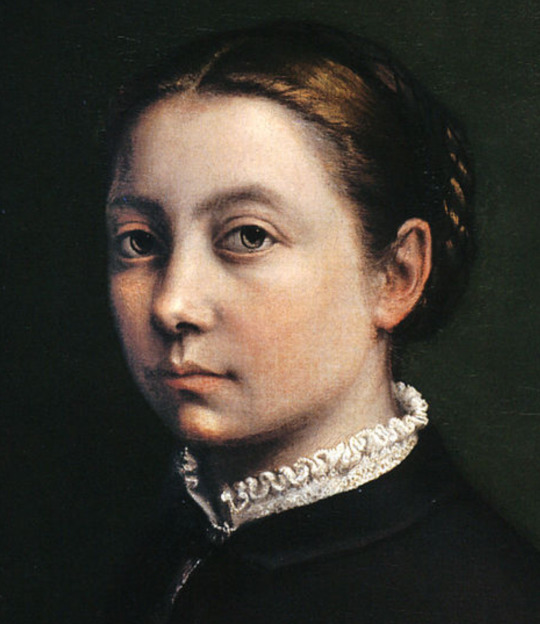
Sofonisba Anguissola
Pintora italiana, 1532-1625. Sofonisba Anguissola fue la mayor de siete hijos en una familia aristocrática. En 1554 viajó a Roma y conoció a Miguel Ángel, quien reconoció su talento. Miguel Ángel incluso le envió algunos de sus propios dibujos para que ella los copiara y le enviara para que los critique.
Su padre se aseguró de que Sofonisba y sus hermanas fueran educadas en bellas artes. Sofonisba fue aprendiz de Bernardino Gatti. A la edad de 14 años su padre la envió, junto con su hermana Elena, a estudiar con Bernardino Campi, pintor también nacido en Cremona, un respetado autor de retratos y escenas religiosas de la escuela de Lombardía. Cuando Campi se mudó a otra ciudad, Sofonisba continuó sus estudios con el pintor Bernardino Gatti (conocido como «El Sojaro»).
Un total de 50 obras han sido atribuidas con seguridad a Sofonisba. Sus cuadros pueden ser vistos en las galerías en Bérgamo, Budapest, Madrid (Museo del Prado), Milán (Pinacoteca de Brera), Nápoles, Siena y Florencia (Galería Uffizi). Su obra ha tenido enorme influencia en las generaciones de artistas posteriores. Su retrato de la reina Isabel de Valois con una piel de marta cibelina fue el retrato más copiado en España. Entre estos copistas se incluyen muchos de los mejores artistas del momento, como Pedro Pablo Rubens.

Pintora italiana, 1552-1614. Lavinia Fontana era hija del pintor de la Escuela de Bolonia, Prospero Fontana, quien formó a Lavinia en pintura. El estilo de Fontana fue, efectivamente, muy cercano al manierismo tardío que practicaba su padre. Ya desde muy joven se hizo un nombre como pintora de pequeñas obras de gabinete, principalmente retratos.
La mayoría de las mujeres que en esta época se dedicaron a la pintura, aprendieron con sus padres. Y muchas se casaron con otro pintor del mismo taller. También es el caso de Fontana que se casó en 1577, con 25 años, con Gian Paolo Zappi. También era pintor del taller de Prospero Fontana y miembro de una familia noble. Tuvo once hijos con él. Siguió pintando durante su matrimonio para ayudar a la familia mientras su esposo se encargaba de la casa y asistía a su mujer como ayudante
Lavinia pintada en muchos géneros diferentes. Trabajó tanto con retratos como con escenas religiosas y mitológicas, que incluían desnudos masculinos y femeninos. Se ha documentado que ha pintado más de 100 obras, aunque solo 32 son conocidas hoy en día.
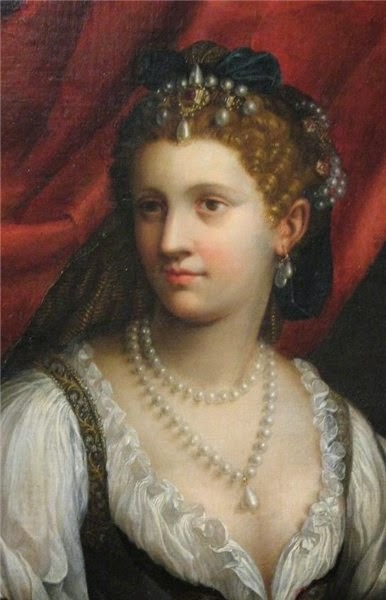
Fede Galizia
Pintora italiana, 1578-1630. Fede Gallizia, mejor conocida como Galizia, nació en Milán en 1578. Su padre, Nunzio Galizia, quien se mudó a Milán desde Trento fue un pintor de miniaturas. De él aprendió Fede a pintar, y se dice que a la edad de doce años era suficientemente considerada artista como para ser mencionada por Giovanni Paolo Lomazzo, pintor y teórico del arte amigo de su padre, de la siguiente forma: «Esta joven se ha dedicado a imitar a nuestros más extraordinarios artistas».
Como hija de Nunzio Galizia, pintor de retratos, Fede Galizia fue un artista consumada a la edad de doce años. Enseñada por su padre, Fede tenía un gran ojo para los detalles y su habilidad para pintar ropa y joyas la convirtió en una retratista muy popular.
Además de los retratos, también le encargaron pinturas religiosas y seculares, y pintó varias representaciones de Judith y Holofernes. Fede. También estaba interesada en los bodegones, por lo que quizás sea más conocida. Fue pionera en el género para mujeres y su estilo ha influido en la evolución de la pintura de bodegones.
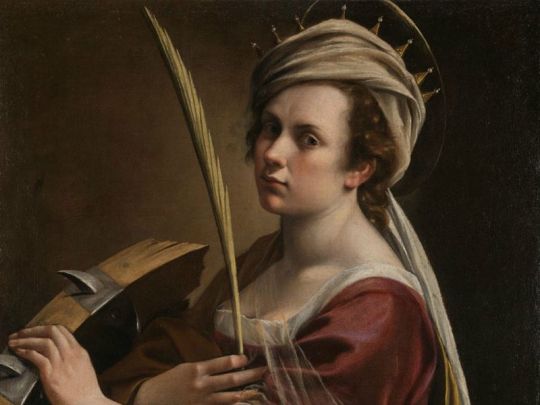
Artemisia Gentileschi
Pintora italiana, 1593-1652. Artemesia Gentileschi, la hija de Orazio Gentileschi, fue una de las artistas mujeres más reconocidas en el Renacimiento. Después de su muerte, la mayoría de las obras de Artemesia se atribuyeron a su padre y otros artistas hasta hace poco. Desde la reaparición de su obra y su historia, ha habido muchos estudios feministas de sus pinturas.
Fue entrenada por su padre, pero fue rechazada de las academias por su género. Luego continuó sus estudios bajo Agostino Tassi. Tassi violó a Artemesia y su padre posteriormente presentó cargos, lo que llevó a un juicio de siete meses durante el cual se le exigió que prestara testimonio bajo tortura. Tassi fue declarado culpable y Artemisia fue reivindicada, y se casó con el artista Pierantonio Stiattesi poco después.
Se dice que el trauma del acoso sexual y el asalto que ella experimentó aparece en sus obras. Estas incluyen varias descripciones de las violentas historias de Judith y Holofernes y Jael y Sisera, así como versiones de Susanna y los ancianos en las que Susanna exhibe terror genuino.

Judith Leyster
Pintora de la Edad de Oro holandesa. Pintó obras de género, retratos y naturalezas muertas. Toda su obra se atribuyó a Frans Hals o a su marido, Jan Miense Molenaer, hasta 1893, cuando Hofstede de Groot le atribuyó siete pinturas, seis de las cuales están firmadas con su monograma distintivo “JL”. La mala atribución de sus obras a Molenaer puede haber sido porque después de su muerte muchas de sus pinturas fueron inventariadas como “la esposa de Molenaer”, no como Judith Leyster.
Existen especulaciones sobre el hecho de que Leyster siguió una carrera en la pintura como resultado de la bancarrota de su padre y la necesidad de traer fondos para la familia. Ella pudo haber aprendido a pintar con Frans Pietersz de Grebber, que dirigía un taller respetado en Haarlem en la década de 1620. Durante este tiempo, su familia se mudó a la provincia de Utrecht, y ella pudo haber estado en contacto con algunos de los Carvaggisti de Utrecht.
Se especializó en escenas de género de retratos, comunmente, de una a tres figuras, que generalmente exudan buen ánimo y se muestran sobre un fondo liso. Muchos son niños, hombres con bebida, etc. Leyster fue particularmente innovadora en sus escenas de género domésticas. Estas son escenas tranquilas de mujeres en el hogar, a menudo con velas o lámparas, especialmente desde el punto de vista de una mujer.
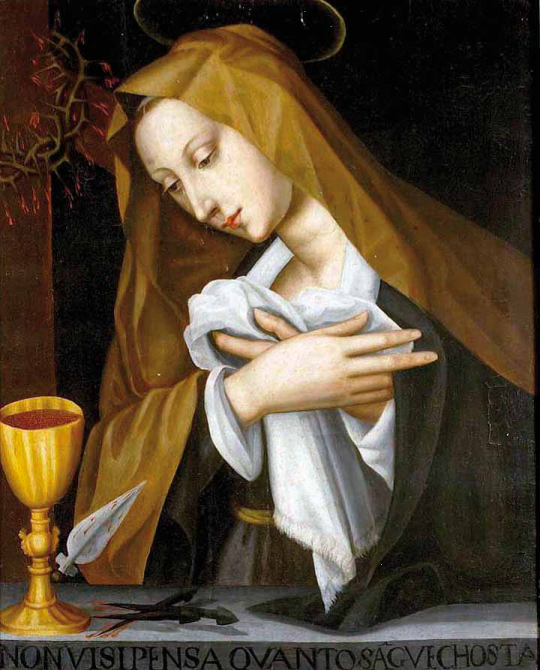
Plautilla Nelli
Sor Plautilla Nelli (1524–1588) fue una autora autodidacta, que era monja, y la primera pintora renacentista de Florencia, Italia. Pulisena Margherita Nelli nació en una familia adinerada en Florencia, Italia. Su padre, Piero di Luca Nelli, fue un exitoso comerciante de telas y sus antepasados se originaron en la zona del valle toscano de Mugello, al igual que la dinastía Medici.
Las predicaciones de Savonarola promovieron la pintura devocional y el dibujo de mujeres religiosas para evitar la pereza, por lo que el convento al que Nelli pertenecía se convirtió en un centro para monjas-artistas. Su hermana, también monja, Costanza, (Suor Petronilla) escribió una vida de Savonarola.
Aunque autodidacta, copió las obras del pintor manierista Agnolo Bronzino y del pintor renacentista Andrea del Sarto. Su principal fuente de inspiración fue la copia de obras de Fra Bartolomeo, que reflejaba el estilo de clasicismo impuesto por las teorías artísticas de Savonarola. Fray Bartolomeo dejó sus dibujos a su alumno, Fray Paolino, quien a su vez los dejó en posesión de “una monja que pinta” en el convento de Santa Caterina da Siena.
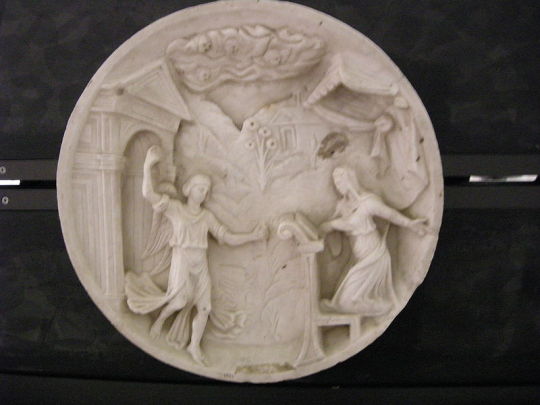
Properzia de Rossi
Properzia de Rossi nació en 1490, en Bolonia, Italia. Fue una de las pocas escultoras que se destacó tanto que Giorgio Vasari la incluyó en su famoso libro “Las Vidas de los Mejores Arquitectos, Pintores y Escultores Italianos”, de 1550. Properzia fue la única mujer escultora de su tiempo.
Era hija de un notario Girolamo Rossi. Sus padres supieron apreciar a una edad temprana el talento de su hija. La joven tuvo la oportunidad de aprender dibujo con grabador Marcoantonio Raimondi, donde se formó con pequeños bajorrelieves. Su pertenencia a una familia boloñesa medianamente poderosa le permitió dedicarse a las artes y acudir a la Universidad.
Su primer contacto con la escultura fue cuando realizó figuras en miniatura con los huesos de melocotones o albaricoques, tallándolos de forma esmerada y delicada, con gran detallismo. Estas piezas estaban consideradas como un objeto de lujo y eran muy solicitadas por la alta sociedad boloñesa. Esta forma de escultura va a hacerla muy popular, de modo que su fama comienza a ascender, comenzando a partir de 1520 a recibir encargos públicos.
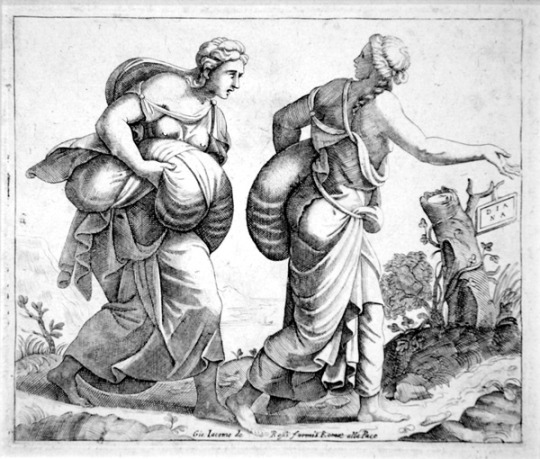
Diana Scultori
Diana Scultori (b.1535 dC) fue una grabadora italiana de Mantua, Italia. Es una de las primeras grabadoras conocidas. Después de su matrimonio en 1575 con el arquitecto aspirante Francesco da Volterra, la pareja se mudó a Roma. Aquí, el enfoque de su trabajo fue reinterpretar obras de artistas vinculados a su esposo y los talleres papales.
Fue una de los cuatro hijos del escultor y grabador Giovanni Battista Ghisi. Diana aprendió el arte del grabado de su padre y del artista Giulio Romano.
La mayoría de las impresiones se hicieron para promover y apoyar su carrera como arquitecto. Fue considerada una mujer de negocios muy interesada, y una de las pocas mujeres artistas a quienes Vasari mencionó en la edición de 1568 de sus Vidas. Trabajó dentro de las restricciones que encontraron los artistas de su época, mujeres o no. Utilizó el trabajo de otros artistas como base para sus grabados, pero la mayoría de los dibujos de sus grabados procedían de su esposo, un miembro de la familia, incluido su padre, o un artista.
Imagen 1: La Nascita di Venere, Sandro Botticelli, pintura sobre lienzo, 1485 – 1486
Imagen 2: Autorretrato, Levina Teerlinc, pintura sobre lienzo, 1560-1565
Imagen 3: Autorretrato, Caterina van Hemessen, pintura sobre lienzo, 1548
Imagen 4: Autorretrato, Sofonisba Anguissola , óleo sobre lienzo, 1554
Imagen 5: Autorretrato, Lavinia Fontana , pintura sobre lienzo, 1580
Imagen 6: Judit con la cabeza de Holofernes, autorretrato, Fede Gallizia , óleo sobre tela, 1610
Imagen 7: Autorretrato como Santa Catherina, Artemesia Gentileschi , óleo sobre lienzo, 1616
Imagen 8: Autorretrato, Judith Leyster , pintura al aceite, 1633
Imagen 9: Virgen dolida, Sor Plautilla Nelli , óleo, no datado.
Imagen 10: José y la esposa de Potifar, Properzia de Rossi, bajorrelieve sobre mármol
Imagen 11: Diana Scultori, grabado.
0 notes